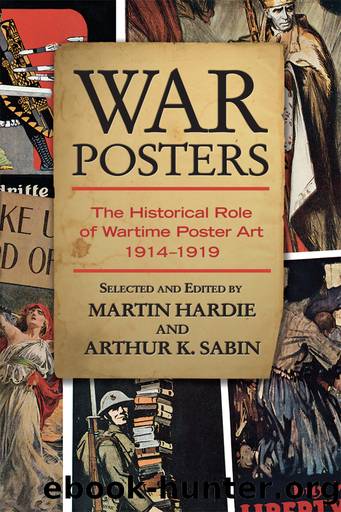War Posters: The Historical Role of Wartime Poster Art 1914-1919 by Martin Hardie & Arthur K. Sabin

Author:Martin Hardie & Arthur K. Sabin [Hardie, Martin & Sabin, Arthur K.]
Language: eng
Format: epub
Tags: Art, History, Military, Non-Fiction, Prints, World War I
ISBN: 9780486816180
Google: nUEfDQAAQBAJ
Amazon: 1371819262
Publisher: Courier Dover Publications
Published: 2016-09-20T23:00:00+00:00
* * *
* It is worth noting that, after Germany had set a value on Raemaeker’s head, her authorities did not disdain to employ his genius, when it suited their purpose, borrowing his famous cartoon “The Dance of Death” for denunciation of Berlin’s mad craze for gaiety, with the words “Sein Tanzer ist Tod.”
V.—UNITED STATES OF AMERICA
IT is a commonplace to say that America is the true home of the advertisement agent; but in considering the history of poster art in the United States, one is surprised to find that so small a proportion of work done in the past shows any striking originality or real grip. In a country whose special capacity has seemed to consist in beating a very large drum repeatedly, often without much provocation, it was to be expected that the very bones and sinews of a poster should be understood, and that results of the highest order should have been obtained. Contrary to this expectation, only a small group of artists doing important work can be named as illustrating the best ability of the revival which, awaking with Chéret, Steinlen, and the others in France, spread to England, and thence normally to America. Of this group, the most able and important exponents of the art were often frankly derivative in their work. Will H. Bradley designed a number of posters which, with those of Penfield, may be said to have brought about the birth of poster art in the United States; but his most successful designs were openly based on the work of Aubrey Beardsley, the originality, charm, and extravagance of whose genius had recently taken the whole art world by storm. And Edward Penfield, whose pronounced ability seemed largely directed to the assimilation of different styles, produced posters excellent in their order, but most of them obvious work by a devoted and imaginative disciple of half a dozen schools varying during the long process of his development. We find him, for instance, producing an admirable American Steinlen in 1897, so clearly and frankly in Steinlen’s spirit, yet with such artistic ability and undoubted personality that it could be placed beside the great French master’s work, be identified with it, and yet retain its own character. This, while excellent in its way, is of course by no means provocative of a real national school, but rather serves to cramp the steps of later exponents of the art, and render their work lifeless; and one is not surprised to find that, after the days of Penfield, Bradley, and Gould, a good many years passed without any striking development in poster art in America. The last ten years, however, have discovered artists of pronounced originality and genius, and the posters of Robert Wildhack, Adolph Treidler, and Maxfield Parrish—to mention only three of the most eminent of their designers of the days immediately before the War—testified to the existence of a genuine national school, and led one to expect vital results in the production of posters inspired by the great world upheaval.
Download
This site does not store any files on its server. We only index and link to content provided by other sites. Please contact the content providers to delete copyright contents if any and email us, we'll remove relevant links or contents immediately.
Wonder by R.J. Palacio(7732)
Unlabel: Selling You Without Selling Out by Marc Ecko(2981)
POP by Steven Heller(2884)
Hidden Persuasion: 33 psychological influence techniques in advertising by Marc Andrews & Matthijs van Leeuwen & Rick van Baaren(2778)
The Pixar Touch by David A. Price(2740)
Ogilvy on Advertising by David Ogilvy(2682)
Drawing Cutting Edge Anatomy by Christopher Hart(2678)
Slugfest by Reed Tucker(2417)
The Art of War Visualized by Jessica Hagy(2412)
The Curated Closet by Anuschka Rees(2385)
Stacked Decks by The Rotenberg Collection(2270)
The Wardrobe Wakeup by Lois Joy Johnson(2235)
365 Days of Wonder by R.J. Palacio(2233)
The Code Book by Simon Singh(2210)
Rapid Viz: A New Method for the Rapid Visualization of Ideas by Kurt Hanks & Larry Belliston(2195)
Tell Me More by Kelly Corrigan(2195)
Keep Going by Austin Kleon(2161)
Tattoo Art by Doralba Picerno(2083)
Tokyo Geek's Guide: Manga, Anime, Gaming, Cosplay, Toys, Idols & More - The Ultimate Guide to Japan's Otaku Culture by Simone Gianni(1947)
